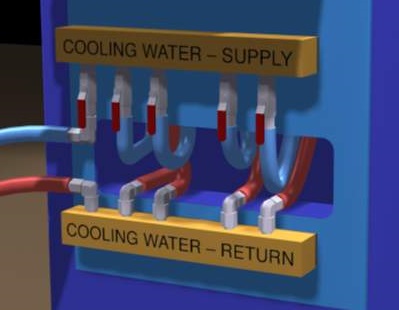The chiller is definitely the proper choice. It’s recirculating water will be routed directly into the internal secondary circuit conductors and the attachment pads on the transformer face. These components carry the high currents and are subject to the most heating.
A fan can only cool the outside transformer surface or cooling fins attached to the outside surface. This would be very inefficient and leave the internal secondary components subjects to heat buildup and possible failure.
Cooling water is critical for all major components of a resistance welder.

Water Manifold
City water or recirculating water from a water tower along with a chiller are acceptable for cooling a resistance welder and its components. All of the water systems are preferred over a fan since they will directly cool the desired component.
The choice between city water, water tower and chiller will depend upon the number of welds, heat generated, capital costs and cost of water and sewers fees. Chillers have the best control but would normally be applied to a limited number of machines. A water tower can cover many machines but its temperature output varies with the season of the year. City water with it’s sewer has fees and environmental impacts to consider. These are the cost/benefits to consider when choosing your cooling system.
A Machine Builder or Distributor can help with these important decisions.
AWS J1.2 recommends that the water be at a temperature or 18-29 deg C (68-85 deg F). The water temperature should not be allowed to cause condensation.
Reference: RWMA Resistance Welding Manual, 4th Edition
AWS J1.2:2016, Guide to Installation and Maintenance of Resistance welding Machines

